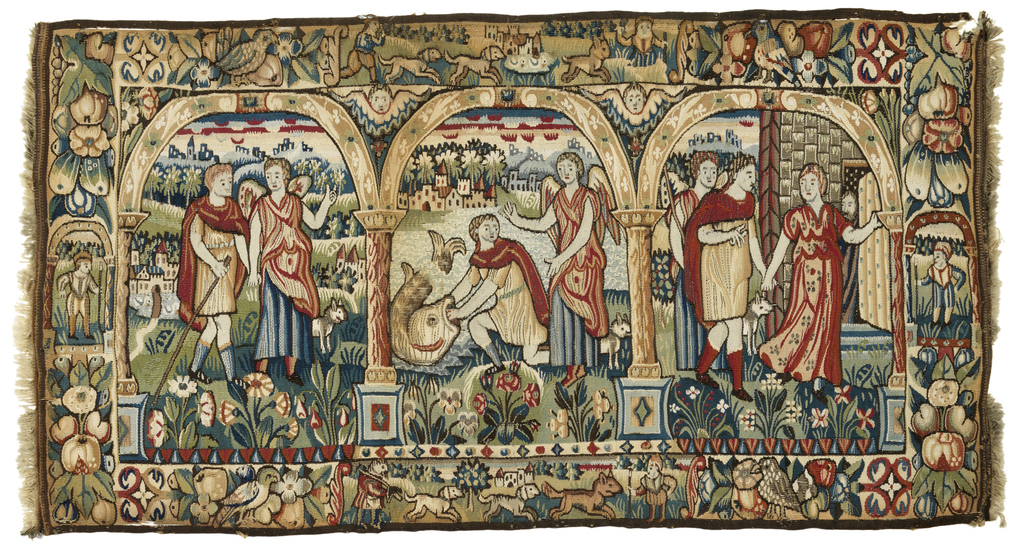
Three scenes from the story of Tobias and the Angel; the journey, Tobias captures the fish, the homecoming.
© T.1-1953 Fitzwilliam Museum, Cambridge
Size: 52.7cm x 101 cm; 20 ¾ inches x 39 ¾ inches, including fringe
Materials: wool, some silk and gold thread
Warp count: 7/8 per cm, 16/17 per inch
Museum Reference: T.1-1953
Acquisition: bought with the help of the Grace Clarke Fund.
Biblical reference: Old Testament Apocrypha, Book of Tobit, scene 1 - departure of Tobias, 5:16; scene 2 - catching the fish, 6:2-4; Scene 3 – return of Tobias and Angel, 11:9
Similar pieces: Two examples showing Tobias catching the fish, 7¼ x 11½ inches (18.0 x 29.0 cm), are known; one is on display at Parham House, Sussex, the other is in a private collection. Two single scenes from a different set, much damaged, are illustrated in E.A.B. Barnard and A.J.B. Wace, ‘The Sheldon tapestry weavers…’, Archaeologia, 78 1928, p.295 and plate xlix. One shows Tobias and Sarah praying on their wedding night, the other Tobias anointing his father’s blind eyes with the guts of the fish.
Story
Tobias was told by his father to collect money deposited with a relative, a merchant in a distant town; before he went he was to find a trustworthy companion. That companion was the Angel Raphael and together with Tobias’ dog they set out. Catching a large fish in the river Tigris they preserved its innards as medicine. When they reached their destination Tobias married the merchant’s daughter, whose previous seven husbands had died on the wedding night. Tobias however, offered parts of the fish as a sacrifice and, also offering prayers, was saved. When he returned home the remaining parts of the fish cured his father’s blindness.
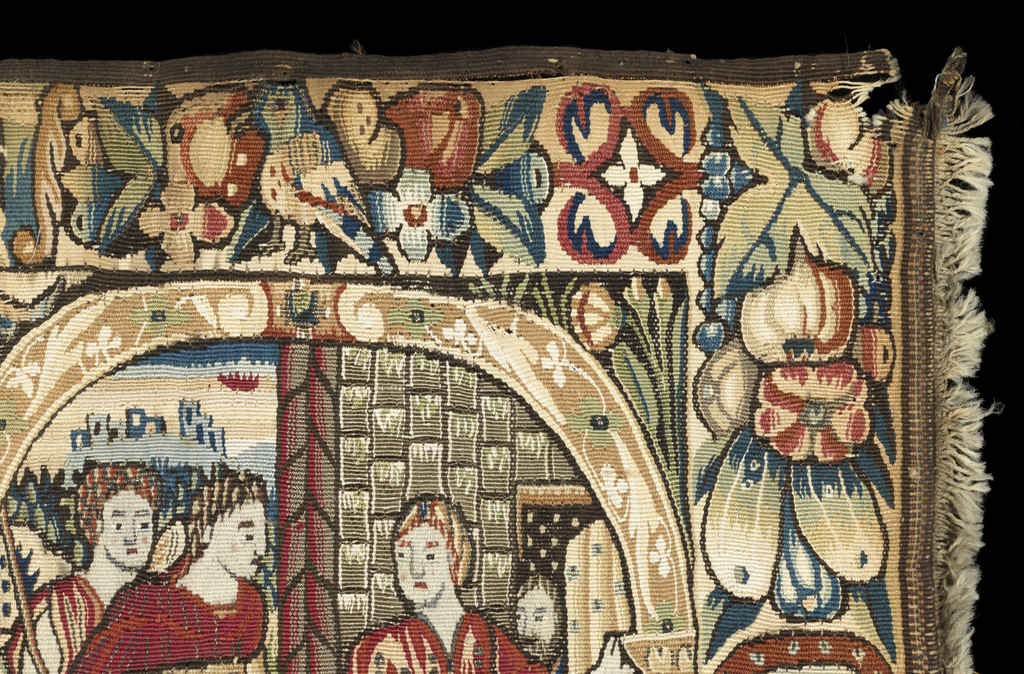
Detail from T.1-1953
© Fitzwilliam Museum, Cambridge
Each of the three scenes is framed within an arch supported by marbled columns – each different - on a curiously insubstantial squared base. As is often seen, the arch, woven in thread now tan but possibly once more nearly red and carrying the elongated leaf and trefoil design, breaks at the top centre, leaving space for a small tablet between the scrolls.
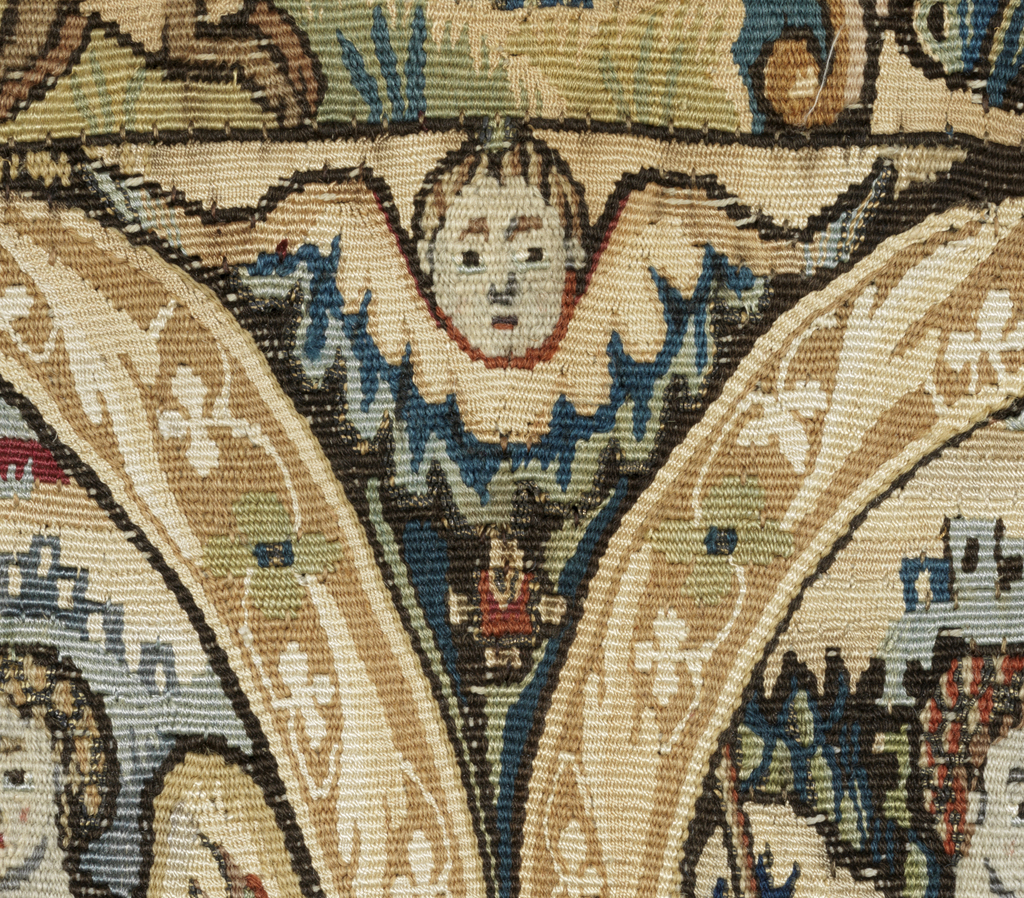
Detail from T.1-1953
© Fitzwilliam Museum, Cambridge
In the spandrels at either side is a carnation, while a cherub’s face peers from swagged fabric between the two middle pillars, a motif not so far found in tapestries called Sheldon.
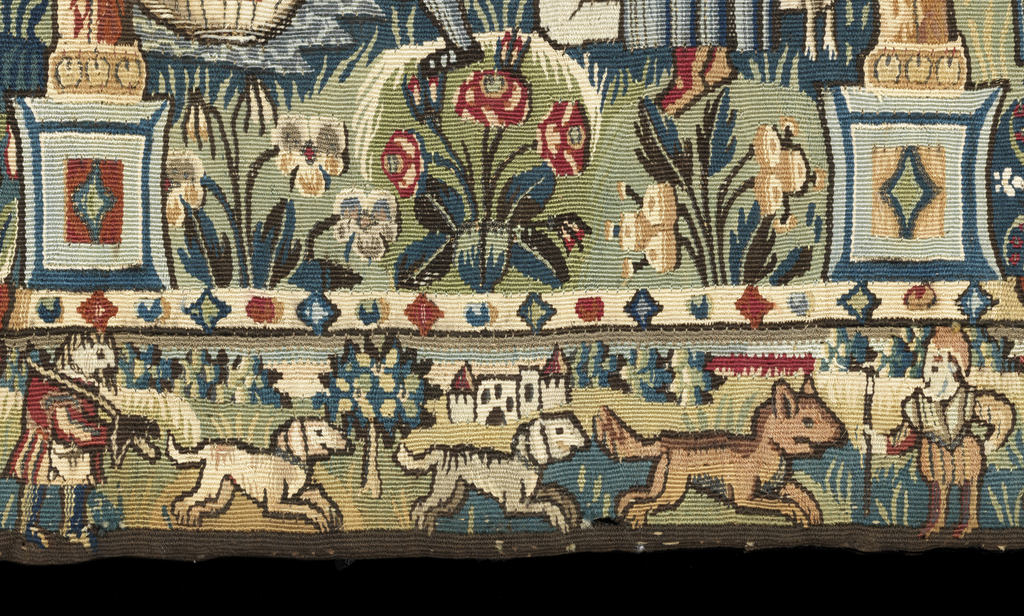
Detail from T.1-1953
© Fitzwilliam Museum, Cambridge
A thin strip of geometric decoration closes the lower edge of each arched section, another unusual feature. The galloon and the now fringed ends of the cut warp threads are complete on each side.
In the first scene the Angel Raphael and Tobias are seen against a mountainous landscape background with a city on the skyline and a moated castle in the foreground. The dress of both figures is heavy with gilt thread, an unusual element, carried over also into the other two scenes. The colours of their respective costumes contrast strongly; Tobias wears a red cloak over his white tunic and grasps a staff; the angel wears a long gown in two parts – red and blue - but is bare-armed. Just visible is a dog, not a fanciful touch but part of the biblical story.
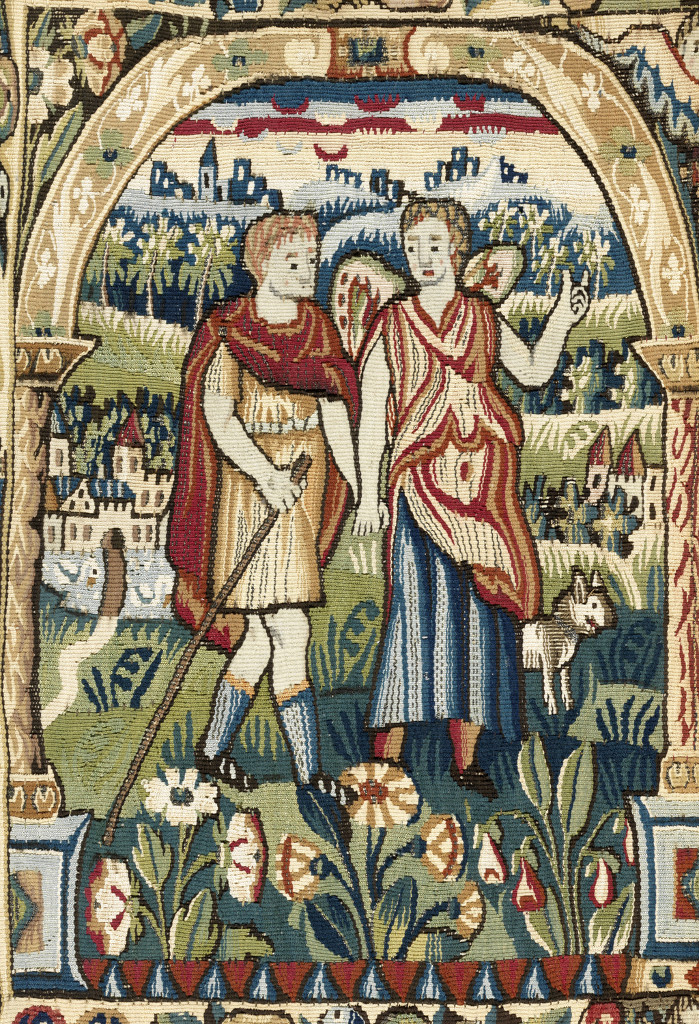 Detail from T.1-1953
Detail from T.1-1953
© Fitzwilliam Museum, Cambridge
In the second scene Tobias wrestles with the fish, watched by the angel but not the dog, dressed in the same strongly contrasting colours as before. The River Tigris, now heavily repaired and looking more like the sea, occupies much of the middle ground; beyond, a large castle stands against a background of mountains and trees. The depiction differs in many details from the two other much smaller surviving examples, one of them on display at Parham House, Sussex, where the background is reduced and the figures become more dominant.
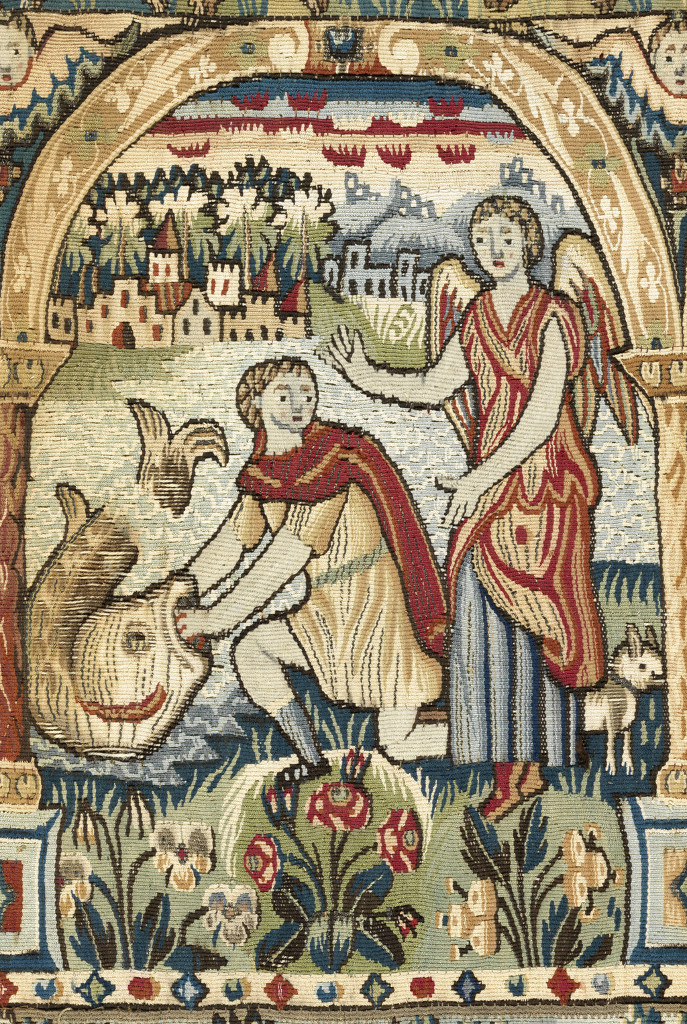
Detail from T.1-1953 © Fitzwilliam Museum, Cambridge
Harder to identify, the third scene probably represents the homecoming of Tobias.
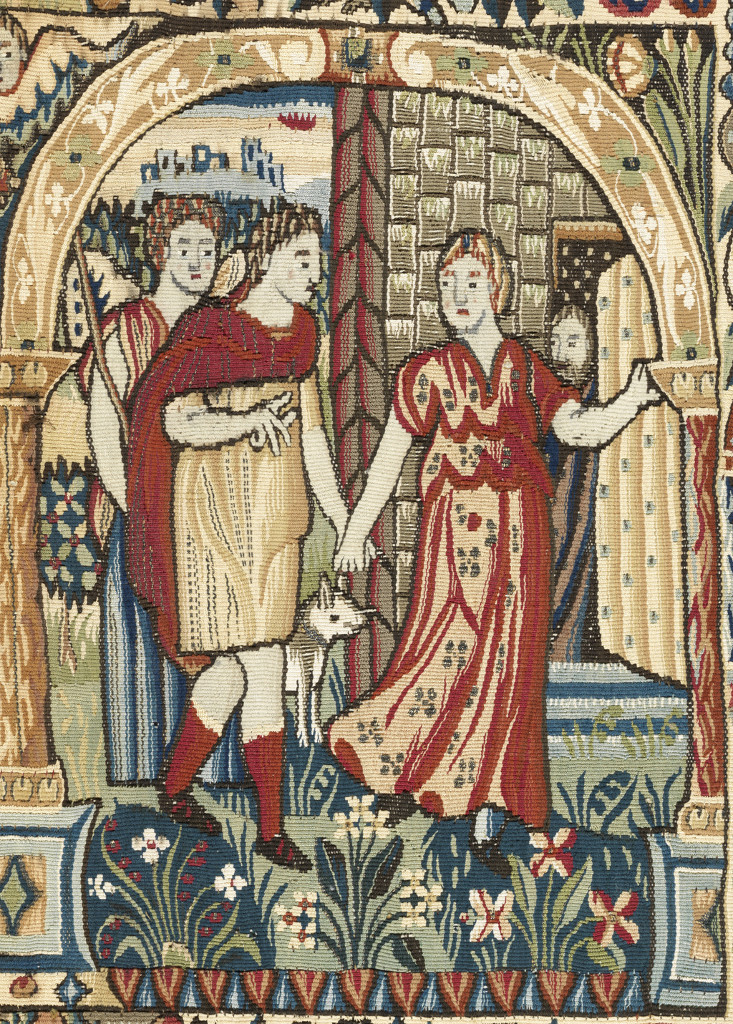
Detail of the front and the reverse sides of the tapestry, T.1-1953 © Fitzwilliam Museum, Cambridge
The biblical account says that his mother rushed out to greet him but that Tobit, his father, stumbled at the doorway because of his blindness. The female figure who dominates the composition is therefore probably his mother, Anna, wearing a red dress sprigged with metal thread flowers; she leads Tobias, followed by a much diminished angel, towards a half-open metal-studded wooden door behind which waits an anxious male figure. It is possible, however, that the scene depicts the travellers’ arrival at their destination. The female figure might then be Sara, cousin of Tobias and his future bride.
The borders

Detail, the lower border, T.1-1953 © Fitzwilliam Museum, Cambridge
Examination of the borders plays an important part in the study of ‘Sheldon’ tapestries. Once considered to be fairly uniform the increased number of tapestries so-called reveals considerable variations. The borders here contain features less commonly met and paralleled in only seven other long cushion covers, only two of which were known to the earliest survey of the tapestries in 1928.
 Detail, the left hand vertical border, T.1-1953 © Fitzwilliam Museum, Cambridge
Detail, the left hand vertical border, T.1-1953 © Fitzwilliam Museum, Cambridge
The centre of the vertical border is occupied by a male halberdier in breeches (depicted in fawn on the left side, and blue on the right), a motif paralleled in work from Oudenarde. Each faces into the field beneath a red arch decorated with dots4. Above and below is an arrangement of leaves, fruit, gourds and a few flower heads not, as so often, in an elongated vase but apparently freestanding.
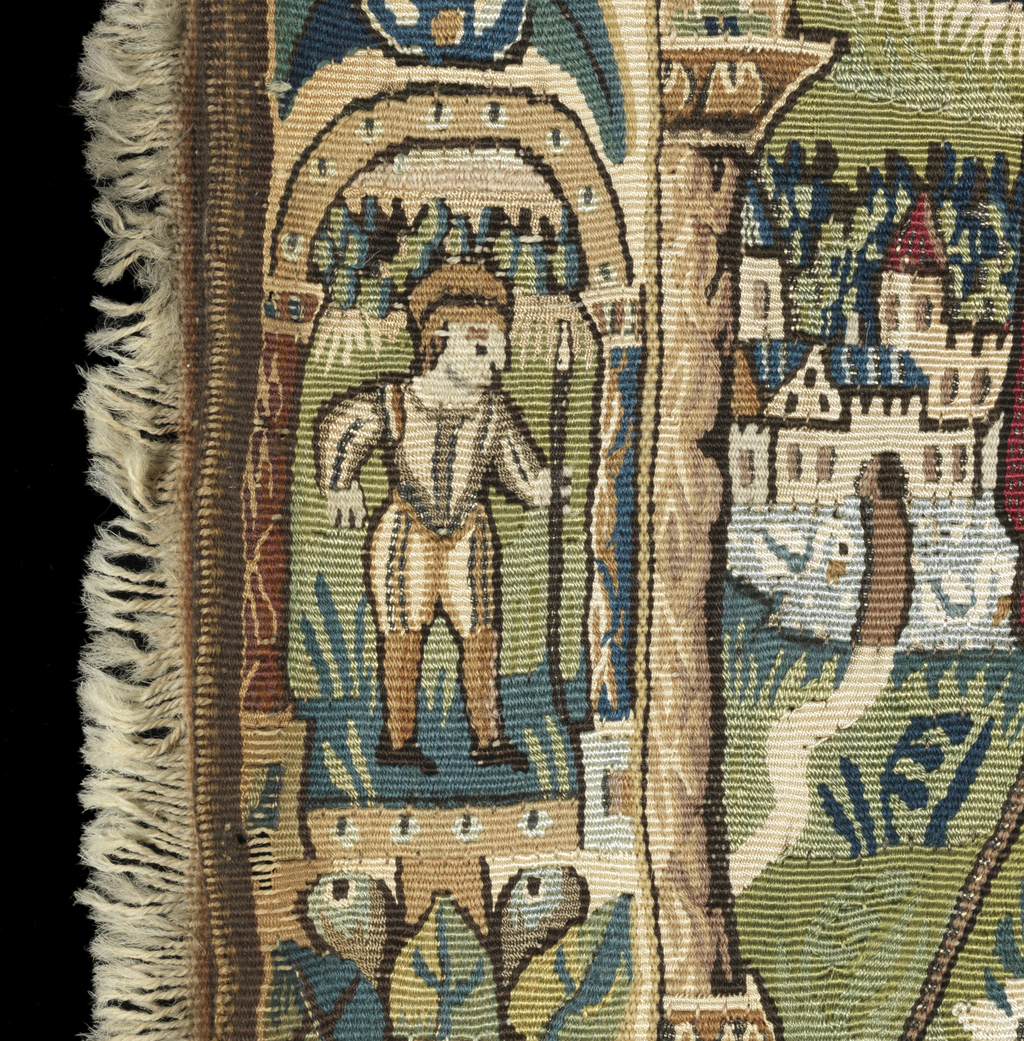
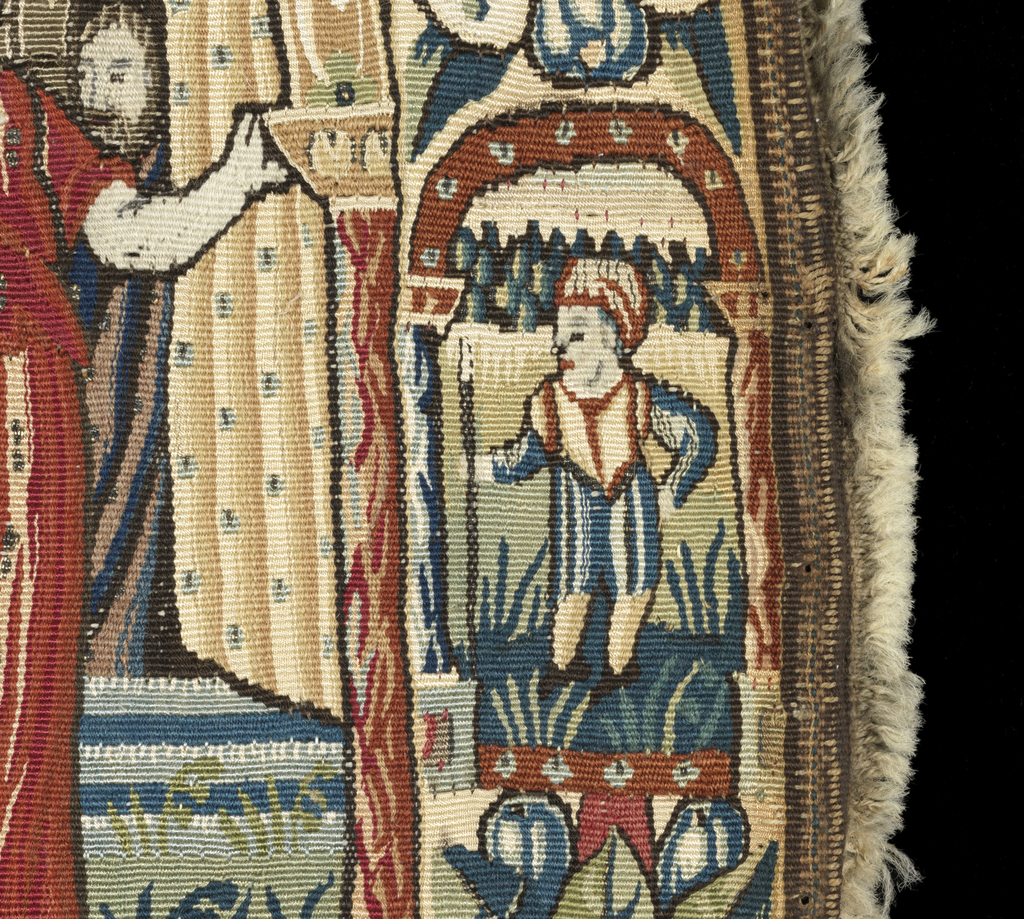 Detail from T.1-1953 © Fitzwilliam Museum, Cambridge.
Detail from T.1-1953 © Fitzwilliam Museum, Cambridge.
Separated from the vertical by a strapwork quatrefoil, unusual in ‘Sheldon’ work, the foliage motif to which a bird has been added continues in the upper and lower borders5.

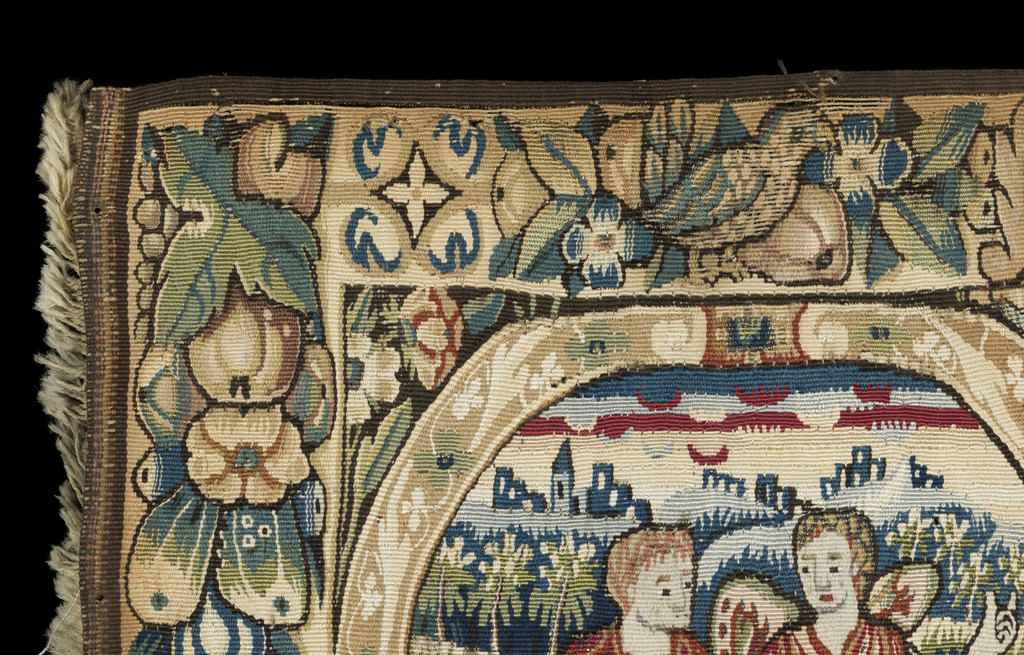
Details from T.1-1953, © Fitzwilliam Museum, Cambridge

Detail from the lower border T.1-1953
© Fitzwilliam Museum, Cambridge
The arrangement is interrupted by one of the many small hunting scenes regarded as typical of ‘Sheldon’ work. In the lower border, however, the figures are more than usually awkward; the fox is almost the size of the watching pikemen.

Detail from the uppper border T.1-1953
© Fitzwilliam Museum, Cambridge
In the upper border both the human and animal figures are almost the same size.
-
The halberdier is seen in borders of Oudenarde tapestry, Sotheby’s, London, 24.11.2004, lot 169, and, with reference to Tapestries Called Sheldon on examples of Judith 9.3 and 9.3.1; Susanna 8.5.2, and on the Prodigal Son, 12.4.1; 12.4.2; 12.5.1, see e.g. Metropolitan Museum, New York.top
-
With reference to Tapestries Called Sheldon long borders are found on Judith and the head of Holofernes, 9.1; three scenes from the Life of Joseph, 10.1.1; Annunciation, Adoration of the Shepherds and of the Kings, 13.2; Faith, Hope and Charity, Lady Lever Art Gallery, 18.1 and 18.1.2 Burrell Collection, Glasgow, 47.19; Prodigal Son, 12.8.1 and 12.8.2. top




